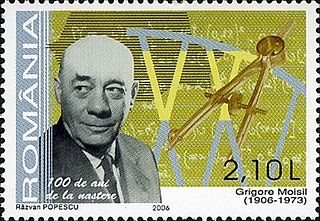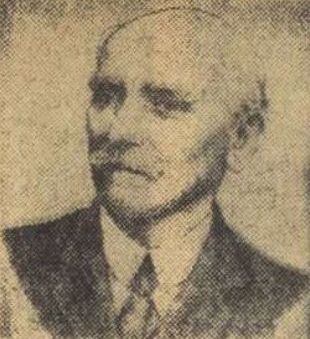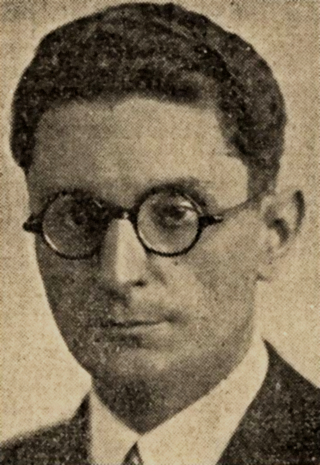Romanian pronunciation: [ˈspiruhaˈret] ; 15 February 1851 – 17 December 1912) was a Romanianmathematician, astronomer, and politician. He made a fundamental contribution to the n-body problem in celestial mechanics by proving that using a third degree approximation for the disturbing forces implies instability of the major axes of the orbits, and by introducing the concept of secular perturbations in relation to this.
Contents
As a politician, during his three terms as Minister of Education, Haret ran deep reforms, building the modern Romanian education system. He was made a full member of the Romanian Academy in 1892.
He also founded the Bucharest Astronomical Observatory, appointing Nicolae Coculescu as its first director. The crater Haret on the Moon is named after him.
Life
Haret was born in Iași, Moldavia, to Constantin and Smaranda Haret, [1] who were of Armenian origin. [2] His baptismal record listed his name as Spiridon Haret. [1] He started his studies in Dorohoi Iași, and in 1862 moved to Saint Sava High School in Bucharest. [3] He showed an early talent for mathematics, publishing two textbooks (one in algebra and one in trigonometry) when he was still a high school student. In 1869 he entered the University of Bucharest, where he studied physics and mathematics. In 1870, while a student in his second term, he became teacher of mathematics at the Nifon Seminary in Bucharest, but quit the following year in order to continue his studies. In 1874, at age 23, he graduated with a degree in physics and mathematics.
After graduation, Haret won a scholarship competition organized by Titu Maiorescu and went to Paris in order to study mathematics at the Sorbonne. There he earned a mathematics diploma in 1875 and a physics diploma in 1876. Two years later (on 18 January 1878), he earned his Ph.D. by defending his thesis, Sur l’invariabilité des grandes axes des orbites planétaires (On the invariability of the major axis of planetary orbits), [4] in front of examiners led by Victor Puiseux, his Ph.D. advisor. [5] In this work he proved a result fundamental for the n-body problem in astronomy, the thesis being published in volume 18 of Annales de l'Observatoire de Paris . Haret was the first Romanian to obtain a Ph.D. degree in Paris.
After his return to Romania in 1878, Haret largely abandoned scientific research and dedicated the rest of his life to improving Romanian education, which was heavily underdeveloped at the time, both as professor and as politician. He was appointed professor of rational mechanics at the Faculty of Science of the University of Bucharest. [4] The next year (1879), Haret became a correspondent member of the Romanian Academy, receiving full membership in 1892. He kept the professorship at the Faculty of Science until his retirement in 1910, when he was followed as professor of mechanics by Dimitrie Pompeiu. From 1882 he was also a professor of analytical geometry at the School of Bridges and Roads in Bucharest. After retirement, Haret occasionally lectured at the informal People's University.
Haret was the Minister of Public Education in three liberal governments, between 1897 and 1899, 1901–1904, and 1907–1910. As Minister of Education he ran a complete reform, basically building the modern Romanian education system.
The folk song "Cântă cucu-n Bucovina" ("Sings the Cuckoo in Bukovina") was composed in 1904 by Constantin Mandicevschi at Haret's request for commemorating the 400th anniversary of the death of Prince of Moldavia Stephen the Great. [6]
In January 1883, he married in Buzău a local, Ana Popescu, 15 years his junior. The two had a son, Ion, who died at age 1, and later adopted a child, Mihai. Haret died in Bucharest in 1912 of cancer, and was buried in the city's Bellu Cemetery; Ana Haret died in 1941, aged 74. [1]
Scientific activity
Haret's major scientific contribution was made in 1878, in his Ph.D. thesis Sur l’invariabilité des grandes axes des orbites planétaires. At the time it was known that planets disturb each other's orbits, thus deviating from the elliptic motion described by Johannes Kepler’s First Law. Pierre Laplace (in 1773) and Joseph Louis Lagrange (in 1776) had already studied the problem, both of them showing that the major axes of the orbits are stable, by using a first degree approximation of the perturbing forces. In 1808 Siméon Denis Poisson had proved that the stability also holds when using second degree approximations. In his thesis, Haret proved by using third degree approximations that the axes are not stable as previously believed, but instead feature a time variability, which he called secular perturbations. This result implies that planetary motion is not absolutely stable. Henri Poincaré considered this result a great surprise and continued Haret’s research, which eventually led him to the creation of chaos theory. Haret established the instability of the model of the n-body problem assuming frequencies to be incommensurable; Poincaré also took into account commensurabilities, and using generalized Fourier series (which generate quasi-periodic solutions), he proved the divergence of these series (which means instability), thus confirming Haret’s result. [7] Félix Tisserand recommended the extension of Haret's method to other astronomic problems and, much later, in 1955, Jean Meffroy restarted Haret’s research using new techniques. [8]
Soon after his return to Romania, Haret abandoned research, focusing for the rest of his life on teaching and, as Minister of Education, on the reform of the education system. He only published an article on the secular acceleration of the Moon in 1880 and one on Jupiter’s Great Red Spot (1912). [4]

In 1910 he published Social mechanics, which used mathematics to explain social behaviour (somehow anticipating the fictional "psychohistory" branch of mathematics developed by Hari Seldon, the fictional character of Isaac Asimov's Foundation, published 40 years later).
Related Research Articles

The University of Bucharest (UB) is a public research university in Bucharest, Romania. It was founded in its current form on 4 July 1864 by a decree of Prince Alexandru Ioan Cuza to convert the former Princely Academy into the current University of Bucharest, making it one of the oldest Romanian universities. It is one of the five members of the Universitaria Consortium.

Politehnica University of Bucharest is a technical university in Bucharest, Romania. 200 years of activity have been celebrated lately, as the university was founded in 1818. Politehnica University is classified by the Ministry of Education as an advanced research and education university.

Constantin Angelescu was a Romanian politician who served as ad interim/acting Prime Minister of Romania for five days, between 30 December 1933 and 3 January 1934.

Gheorghe Țițeica publishing as George or Georges Tzitzéica) was a Romanian mathematician who made important contributions in geometry. He is recognized as the founder of the Romanian school of differential geometry.

Grigore Constantin Moisil was a Romanian mathematician, computer pioneer, and titular member of the Romanian Academy. His research was mainly in the fields of mathematical logic, algebraic logic, MV-algebra, and differential equations. He is viewed as the father of computer science in Romania.

David Emmanuel was a Romanian Jewish mathematician and member of the Romanian Academy, considered to be the founder of the modern mathematics school in Romania.
Constantin Schifirneț is a Romanian sociologist and historian of philosophy.

Gheorghe Tașcă was a Romanian economist, lawyer, academic, diplomat, and politician. He was a corresponding member of the Romanian Academy.

The National University of Arts in Bucharest is a university in Bucharest preparing students in fine arts. The National University of Arts is a higher education institution in Bucharest.

The Spiru Haret University is a private university in Bucharest, Romania, founded in 1991 by the president of Tomorrow's Romania Foundation, Aurelian Gh. Bondrea, as part of the teaching activities of this foundation. The university claims this has been done according to the model used by Harvard University. The university bears the name of a scientist and reformer of the Romanian education, Spiru Haret, who lived before World War I.

The Frații Buzești National College is a high school located in central Craiova, Romania, at 5 Știrbei Vodă Street. It is one of the most prestigious secondary education institutions in Romania.
Barbu Brezianu was a Romanian poet, art critic, art historian and judge.
Dan Berindei was a Romanian historian. He was a titular member of the Romanian Academy from 1992 until his death.

Victor Vâlcovici was a Romanian mechanician and mathematician.
Spiridon Popescu was a Romanian prose writer.

Dinu Pillat was a Romanian literary critic and prose writer.
Constantin Noe was a Megleno-Romanian editor and professor. He was born in 1883 in the Megleno-Romanian village of Lagkadia, then in the Ottoman Empire and now in Greece. He was one of the best students of the Romanian High School of Bitola, from which he graduated in 1903. On the same year, Noe became professor in several of the Romanian schools in the Balkans and one of the main figures of the Megleno-Romanian national movement. In 1907, he and several others of his colleagues were arrested and sentenced to four months in prison under the pretext of not using books approved by the General Directorate of Education of the Salonica vilayet of the Ottoman Empire in the schools they were teaching at.

"Cântă cucu-n Bucovina" or "Cântă cucu în Bucovina" is a Romanian folk song, more precisely a doină, composed in 1904 by Constantin Mandicevschi. The lyrics are original, while the melody is a modified Bukovinian mourning song. Mandicevschi composed it at the request of Spiru Haret for the 400th anniversary of the death of Prince of Moldavia Stephen the Great, which was commemorated in Putna in the same year. The song is also known as "Cântă cucul, bată-l vina", "Bucovină, plai cu flori", "Cântec pentru Bucovina" and "Cântec despre Bucovina".
The Astronomical Institute of the Romanian Academy was created in 1990 with the union of three astronomical observatories: the Bucharest Astronomical Observatory, the Cluj Observatory and the Timișoara Observatory.
References
- 1 2 3 Iulian Bunila (14 October 2015). "Femeia care i-a sucit mințile lui Spiru Haret. Primul român cu doctorat în matematici la Sorbona s-a îndrăgostit de o adolescentă cu 15 ani mai tânără". Adevărul (in Romanian). Retrieved 21 February 2022.
- ↑ Camelia Badea (10 February 2013). "Mari politicieni români: Spiru Haret, reformatorul societății românești". ziare.com (in Romanian). Retrieved 21 February 2022.
- ↑ "Despre Spiru Haret". www.fsespiruharet.ro (in Romanian). Federația Sindicatelor din Educație "Spiru Haret". Retrieved 21 February 2022.
- 1 2 3 O'Connor, John J.; Robertson, Edmund F., "Spiru Haret", MacTutor History of Mathematics Archive , University of St Andrews
- ↑ Spiru Haret at the Mathematics Genealogy Project
- ↑ "Constantin Mandicevschi – autorul renumitului cântec românesc "Cântă cucu-n Bucovina"". Timpul (in Romanian). 24 July 2017.
- ↑ Magda Stavinschi; Vasile Mioc (2004), "Astronomical Researches in Poincaré's and Romanian Works", in Nicole Capitaine (ed.), Journées 2004 (PDF), Paris Observatory, pp. 155–156, ISBN 2-901057-51-9
- ↑ Jean Meffroy (1955). "Contribution a L'Étude de la Stabilité du Systéme Solaire". Bulletin Astronomique (in French). 19: 197–221. Bibcode:1955BuAst..19..197M.
- Ion Bulei (1990), Atunci când veacul se năștea... lumea româneasca 1900–1908[When the century was born... the Romanian world 1900–1908] (in Romanian), Editura Eminescu, pp. 82–96
External links
- Constantin Schifirneț, "Spiru Haret, reformatorul societății românești" [Spiru Haret, the reformer of Romanian society], Studiu Introductiv la Operele Lui Spiru Haret, Vol. I, Editura Comunicare.ro, 2009, Pp. 13-42 (in Romanian)
- Constantin Schifirneț (2014), "Spiru Haret, Education and School Legislation Reform" (PDF), Revista română de sociologie, XXV (3–4): 311–326
- Sorin-Avram Vîrtop (2019), "Beyond mythology and tradition of an educational reform or about the realism of Spiru Haret's educational reform (1851–1912)" (PDF), Analele Universității "Constantin Brâncuși" din Târgu Jiu, 2 (2)
- "Spiru Haret". bsclupan.asm.md (in Romanian). Andrei Lupan Central Scientific Library . Retrieved 21 February 2022.
- "Liga Spiru Haret". Archived from the original on 11 April 2009.
Spiru Haret | |
|---|---|
 | |
| Born | Spiridon Haret 15 February 1851 |
| Died | 17 December 1912 (aged 61) |
| Resting place | Bellu Cemetery, Bucharest, Romania |
| Nationality | Romanian–Armenian |
| Education | Saint Sava National College |
| Alma mater | University of Bucharest University of Paris |
| Known for | N-body problem Romanian education system |
| Spouse | Ana Popescu (m. 1883) |
| Scientific career | |
| Fields | Mathematics, Astronomy |
| Institutions | University of Bucharest School of Bridges and Roads |
| Thesis | Sur l’invariabilité des grandes axes des orbites planétaires (1878) |
| Doctoral advisor | Victor Puiseux |
| Minister of Religious Affairs and Public Instruction | |
| In office 31 March 1897 –30 March 1899 | |
| International | |
|---|---|
| National | |
| Academics | |
| People | |
| Other | |